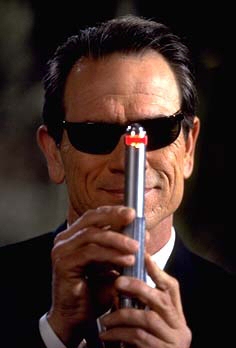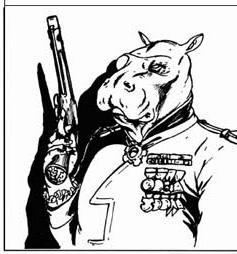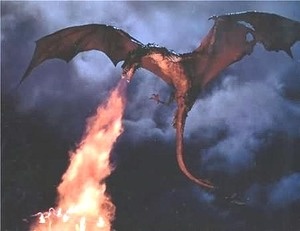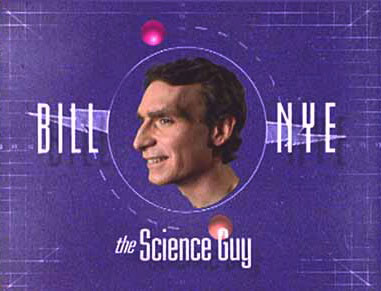It all starts with a nice voice. A voice with some strength in it; little bit of breath, little bit of smoke, ya know? Hair is variable, but I like unnatural colors: jet black or bright red. Tall is good and definitely not a rail: a little bit of padding is nice, so is some muscle. And of course huge tracts of…
Ahem.
Oh. right. Not that fantasy. Sorry about that, folks. Sometimes I go back over my notes for what I want to blog about and I’m not very specific. It just says ‘fantasy’ here and… well yeah. Let’s start over.

Those earlier words were just swamp gas.
I think a lot of people, when you say ‘fantasy’ get a very specific picture in their heads: a knight in full plate, a damsel with one of those goofy cone hats with the single ribbon that makes it not a dunce cap, a castle that’s really just a single tower with a crenelated parapet, and a big, green dragon breathing fire. The weird thing is that I have never, and I mean never come across this story in written form.
Seriously, my history with the genre goes deep, from Dealing With Dragons to Magic Kingdom For Sale, to The Matter of Britain (ie: the King Author stories), to the codifier of 80% of the tropes in the genre, Lord of the Rings; and I have yet to see that actual scene play out in a book.
It happens in other media, certainly. Whenever the cartoons of my youth, like Ducktales decided to do a fantasy (or even just medieval) themed episode, you’d get the tower and the green dragon and a ton of knights, so that all had to come from somewhere right?
Just to cover my bases, I will acknowledge right here and now that someone reading this will be able to recall a book with this and comment on it. So, you know, go ahead.
But my pet theory is that as kids, we’re bombarded with a lot of fantasy and speculative fiction in general at an age where we won’t fully remember everything as an adult. The result is an archetypical rendering of a bunch of recurring themes into a single mental composite for easy reference. Then writers, usually for kids shows, looking for a pastiche, take that composite and run with it, ingraining that image further.
That’s why I think you get people who can honestly watch Game of Thrones or Legend of the Seeker and then say with a completely straight face that they don’t like Fantasy The same can go for Science Fiction or Horror or the Superhero genre, but those are other articles.
As is my MO, I like to look at things like this from the consumer side of things, which is a viewpoint that gets overlooked a lot. I could write an entire article on this idea of mine, but to boil it down; you hear a lot about media from just two perspectives—the creator and the critic. You rarely hear from the actual viewer. Creators and critics are all about the technical stuff and the kind of things you have to take classes of be Very Serious about media to understand or care about. The consumer perspective is ‘do I like it’ and ‘why’. And frankly, I don’t think people who aren’t trying to cynically squeeze money out of consumers give that enough love.
And so, looking at it from that perspective, I’m going to attempt to break fantasy down like I’ve done other genres and tropes on this blog. And the first lesson…
Fantasy is Personal
Like a lot of my better understanding of fantasy, this concept comes from my years of playing Dungeons and Dragons. For those of you not familiar with D&D, it’s a fantasy roleplaying game where you get to play as a character in a fantasy world. D&D is actually just the ruleset though and there is only the most vague notion of a ‘D&D World’. Instead, you can buy books that detail what’s called a campaign setting that gives you a whole world with its own flavor, story and accompanying tropes.
If you roleplay at all, you probably know about D&D’s famous edition wars, where the game makes periodic changes to the ruleset and fans go to each other’s throat over which is better (incidentally, 4e is better), but you might not be aware of the setting wars. Most D&D players have a favorite and will got to the plate with a nailbat to ‘prove’ that their setting is the best and the others suck. Worse, given the production cycle of the game, not ever setting will be updated to every new edition, fueling the feud even further.
And then there are people like me who aren’t entirely happy with any setting that’s been offered. I enjoy the concept and tongue-in-cheek nature of Spelljammer and the ‘take magic to its logical conclusion and break medieval stasis‘ themes of Eberron while heavily disliking the the alignment centered focus of Planescape and the darkness of Ravenloft, but nothing really fits me perfectly.

Spelljammer in a nutshell.
At the moment where I was in my very first game, set in the Forgotten Realms and found myself thinking ‘well I’m not really happy with this part and this part’, I also became aware of how personal fantasy preferences are.
I believe that most people enjoy some level of Fantasy, but exactly what type of fantasy they enjoy is based on several sliding scales of preference, some of which are universal and some of which are unique to spec-fic or fantasy writ large.
The first of these is The Fantastic.
‘Well durr’, you might be saying, ‘Of course Fantasy hinges on the fantastic’, but you might be surprised at the variance here. It’s not even a sliding scale, but a series of sliders.
Some people, while they appreciate fantasy, cannot accept that the rules of biology and/or physics might be different on another world. These are the people who complain bitterly about huge swords, incredible acts of acrobatics, and non-magical weirdness. They have a very low tolerance for deviation from Earth Normal unless its is explicitly magic or some of other type of phlebotinum. Even among these people, there are factions that will relent for staples of the genre like dragons and those who are genuinely bothered by the anti-logic of dragons, especially those that are presented as non-magical being hexapodal, multi-ton fliers with fire breath. ‘naturally’ magical things like mandrakes et all tend to bother them.

But all I care about is how unrealistic this is.
Works that follow this idea might exclude magic altogether, or hide it to parcel out in small doses (and even then, it is rarely flashy), have very few non-human races and just as few monsters. A Song of Ice and Fire (most people by now know it just as Game of Thrones) does this.
A step above this is the most widely held attitude is acceptance of what I call the Basic Fantastic. Here, fans will accept spells being cast that are big and flashy as a rule, gods and monsters are everywhere, and you have you basic fantasy races: elf, dwarf, orc, goblin.
This is where ‘traditional’ fantasy lies: your Lord of the Rings (and imitators), your Conan, Hercules: the Legendary Journeys (and Xena: Warrior Princess), and modern fantasy stories like Charmed and even stuff like Twilight.
It’s something I think of as ‘comfort fantasy’. Like reaching for mashed potatoes or macaroni and cheese, it’s familiar, non-scary and no matter how deep or shallow, you know basically where you are. Most of the monsters are cribbed from mythologies we know and have powers we’re familiar with. You’re going to get vampires, demons, genies, ghosts and werewolves and that’s Okay.
I don’t want to give the impression that I don’t like or disapprove of this level of Fantastic; I love a lot of these works, but as a writer, I find them constraining. When you write comfort fantasy, you Are Not Allowed to monkey around too much with the set pieces and monsters and I love making monsters and drawing from lesser known mythologies, which can upset reader expectations when you’re presenting an otherwise ‘normal’ fantasy story.
Magic is also a big thing. The preference here is to just let magic be magic without really explaining it too much or delving too deeply into the mechanics of it. I guess the minutia of magic systems is pretty nerdy by itself and most people just aren’t that nerdy. Well I am.
And finally, you are pretty much stuck with medieval Europe or modern day for your setting. There’s occasionally the Asian or Arabian variant, but (and this happens a lot in D&D settings), they’re pretty much direct riffs on a a given real world culture that the audience recognizes.
While I like reading these stories, when I write, I like getting into the meat of these things and going a little bit weird.
And as luck (and article structure) would have it, that’s the next step along the scale; something I like to call The Weirdness Threshold.
In a previous article, I talked about how far alien a writer can go in their writing and a little about the New Weird subgenre. The Weirdness Threshold is the bridge between ‘comfort fantasy’ and New Weird, characterized by adding in a wealth of unique elements without really kicking the comforting stuff to the curb.
The threshold is where you’ll most often find the Five Races trope, where there are five ‘good’ or at least ‘non-monster’ races: usually humans, elves, dwarves, and two wildcards, one of which is usually a setting specific race or something drawn from a more obscure area of mythology (merfolk, rat people, centaurs, etc).
Worlds also start to be more distanced from Earth with unique constructed cultures that are divorced from known cultures, fusions of tow or more, or drawn form lesser understood Earth cultures. And on a related note, it’s in the threshold that magic starts to be an influence in the world to the point that it is often treated as a physical force and studied like a science.

A modern wizard in his natural habitat.
At the threshold, you start to see magic being more common and use for more mundane tasks with cultures and economies built around the understanding that magic is a real thing people are capable of in the world. More detail is devoted to how things work; be it magic or traditions or social dynamics, purely because writers in this style understand that the audience is not familiar with what they’re doing here.
Monsters too become more varied, with powers not taken from mythology. They can get weird and often they become more like plot points than dangers or threshold guardians (not related to the weirdness threshold).
Brandon Sanderson, who anyone that reads this blog at all will know is one of my heroes, writes in the threshold a lot with deep focus given in each book to the local magic system (usually more than one) and cultures. His book The Way of Kings in particular revels in this with a world where evolution itself has given rise to a world where crustaceans are the dominant order of animals and plants now retract in the presence of movement thanks to seasons of horrible storms.
And yes, in reality, this is where Lord of the Rings would be if it wasn’t Lord of the Rings or a direct imitator. Most people don’t know the much deeper history of the setting and what’s written in the Similaron, and so don’t realize how ‘weird’ LotR gets, what with orcs being genetic experiments and how the various gods and angels work.
Writing on the threshold is very freeing. The traditional tropes are still there to grab and use, but you’re still able to branch out and do things that aren’t expected, adding new twists to old ideas.
My only gripe here is that (and I suppose it’s true in all fantasy) there remains an expectation that fantasy-world humans are ever and always the exact same creature as Earth humans, even though we know for a fact that some very strange things happen to human physiology if you just vary the gravity, oxygen content in the air, or amount of exposure to the sun a people get.
In science fiction, you’re ‘allowed’ to get away with evolution taking its course on space-born humans, but for some reason a world filled with magic and plants you can boil to get potions cannot justify a human that can jump higher than an average (not even Olympic medalist) human.
This is why I actually rebelled a bit in Rune Breaker. It’s subtle, but if you read carefully, you’ll notice that the human race that Ru belongs to is actually not the same human race that Kaiel belongs to (eye colors in the previous world were yellow, orange, violet and black). Ancient Erean Humans like Ru dies off and The Vishnari gods brought humans from other worlds when they arrived, including the Chordinis, who we will later find out have bluish white skin tones.
This may be the one constraint tha is still obeyed by the obvious next step I’ve already mentioned:
New Weird. This is what happens when a writer looks at the current conventions and says ‘I don’t care, I’ll do what I want’. Correction: when a sane writer does this. We’ll get to the other kind in a minute.
This is where everything becomes new. There may be a few traditional trappings, but the majority of concepts that are being brought to the table are new and there are very few limits. There might not even be humans in a new weird work, which edges into what’s called xeno-fiction. Magic, culture, and yes, the laws of physics themselves are up for grabs, though very few tinker with that last one.
It’s also at this point where exposition becomes very important, almost an art in and of itself, because the audience can very easily get lost. It’s also easy for a writer to lose their grip on what their trying to do and go flying out into space without warning.
Despite the dangers, new weird is where most of the trails are being blazed in speculative fiction, taking fantasy to the bleeding edge where it becomes almost indistinguishable from science fiction. Works like Neil Gaiman’s American Gods (part of the inspiration for Spider’s 7), and China Mieville’s Perdido Street Station are prime examples of the amazing things that can be done out here.
I’ve said before that new weird is testing fantasy to the edge of destruction, but it’s not the absolute edge. If a writer steps out on that edge on purpose to have fun, you come to a place I like to call the Absurdist Fringe. Out on the fringe, you find self-aware works that know and understand the traditions of fantasy and play with them hard and fast, often for humor.
Here is where you find Terry Pratchett’s Discworld, Piers Anthony’s Xanth, Eoin Colfer ‘s Artemis Fowl series, and Jasper Fforde’s Nursery Crimes. These are works that acknowledge that at their core, a lot of fantasy tropes and trapping at really kind of silly, then they throw up their hands and admit that they’re also a lot of fun.
In taking those traditional concepts and playing with them in many different ways, they keep the comfortable familiarity while presenting a whole new feel to the finished product. In this way, they take the thing that readers might not tolerate normally, like overt magic and weird races, and put then in a light that makes them easier to digest.
As a writer, I have a great deal of respect for those who are out here doing their thing because in requires an incredible grasp of both the genre and the audience to pull off. That it’s resulted in so many great stories that I personally love is a testament to what masters these writers are.
For my own part, I don’t usually play out here because I am not a master. But if you remember the little pilot concept: The Face-Punch Academy for Proper Warrior Women, that was a weather balloon to see how readers responded to an attempt on my part. I really liked the idea, but a lack of response put it on the back burner for now.
Beyond this is the creativity trap, where the writer not only ignored convention, but the ability of the audience to relate to what’s going on in the story. They blow through everyone and just say ‘everyone else be damned, I’m going for broke and making everything new.
And it can work. Yes it can. I see it a lot in anime that usually isn’t even listed as fantasy, like Hellsing, or Full Metal Alchemist and in general fantasy with crazy twists like Scrapped Princess and Zero no Tsukaima. These result from alloying fantasy with other genres in such a way that it’s impossible to extricate the two and the audience is just thrown into the the fray with little explanation, or explanations that turn out to be wrong in-universe.
Comics stray into it too, usually because magic is an afterthought. The psychedelic cosmic stuff in Doctor Strange definitely fits, as does Alan Moore’s Swamp Thing.
And the definitive example of the far flung recesses of space as far as fantasy is concerned is the American animated series He-Man
Fur Panties!
He-man is set on Eternia, which is a fantasy-esque world with swords and castles and insanity. Every being seems to represent a species all their own, magic is ‘whatever happens, yo’, people ride giant cats, there’s a different world somewhere nearby the She-ra Princess of Power hangs out on and as a general rule, no one gives a good goddamn about explanations.
Eternia is chaos congealed into solid form. Looking at it even casually reveals that it makes totally no sense.
And every second you spend there is awesome.
Stay tuned for more Fantasy talk next week. Until then, enjoy a link to a bunch of He-man YouTube videos. Because Uncle Vaal loves you.




